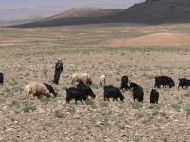Things to know about nomadic resource utilisation
Nomadic regions are mainly located in the dryland belt of the Earth. These regions are characterised by scarce and highly variable precipitation, or – as is the case in high altitudes or subarctic regions – by a short vegetation period, both of which impede agriculture. Hence, extensive livestock breeding (pastoralism) is an important form of land use, and pastures represent a key natural resource for livelihoods. When travelling across nomadic regions, however, you will realise that pastures do not resemble one another but differ in terms of composition, density and productivity of their vegetation cover. Why is this? The state of each pasture is influenced by various factors: soil type, climatic conditions such as precipitation and temperature, but also the way the rangeland is used.
This, however, is merely one side of the coin. The decision of every nomadic household on their pasture use (e.g. when to move, to what pasture, whether to purchase supplementary feed, when to sell how many animals) is also influenced by a bundle of factors, including the income required for securing one’s livelihood, but also the resources available to the household (cf. Breuer 2007). The spectrum of relevant resources is diverse. Examples include the available labour force, monetary resources, access to pastures, but also integration into social networks (of relatives, neighbours, cooperatives) that are important for coping with risks. Moreover, decision-making is influenced by administrative regulations and by current market conditions (cf. Bretan 2010).




